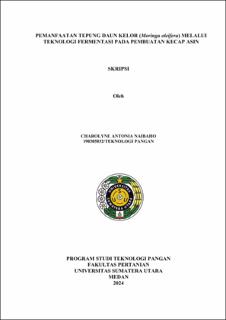Pemanfaatan Tepung Daun Kelor (Moringa Oleifera) melalui Teknologi Fermentasi pada Pembuatan Kecap Asin
Utilization of Moringa Leaf Flour (Moringa oleifera) Through Fermentation Technology in Soy Sauce Making

Date
2024Author
Naibaho, Charolyne Antonia
Advisor(s)
Sinaga, Hotnida
Lubis, Zulkifli
Metadata
Show full item recordAbstract
This research was conducted to determine the effect of Moringa leaf flour concentration and salt solution concentration on the quality characteristics of soy sauce. This research used a factorial completely randomized design consisting of 2 factors, namely moringa leaf flour concentration (A): (0%; 10%; 20%; 30%) and salt solution concentration (G): (18%; 22%; 26). The parameters analyzed in this study consisted of the color index, acidity degree (pH), total dissolved solids, viscosity, water content, ash content, protein, carbohydrates, fat, total flavonoids, and organoleptic (hedonic) tests. The results of the research show that salt concentration had a highly significant effect on the degree of acidity (pH), total dissolved solids, water content, ash content, and carbohydrate fat and had significant effect in taste hedonic and general acceptance hedonic. The concentration of Moringa leaf flour had a highly significant effect on the degree of acidity (pH), total dissolved solids, water content, ash content, fat, protein, carbohydrates, color index, as well as significant differences in color hedonics, aroma hedonics, taste hedonics, and hedonic general acceptance. The interaction of salt concentration and Moringa leaf flour concentration had a highly significant effect on the degree of acidity (pH), color index, carbohydrates, color hedonics, aroma hedonics, taste hedonics, and general acceptability hedonics. The research results showed that A4G2 was treated as a soy sauce with the best quality characteristics.
Collections
- Undergraduate Theses [638]
